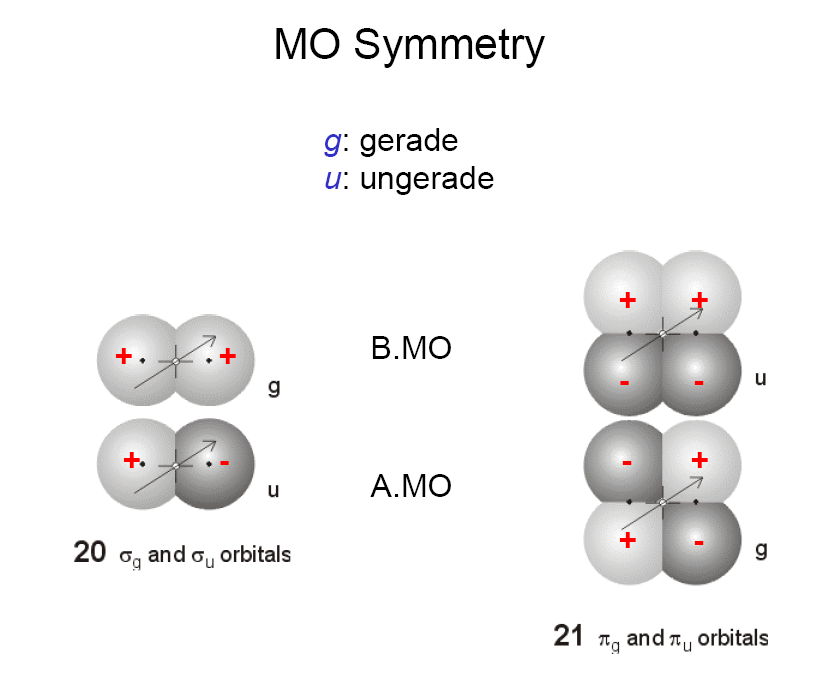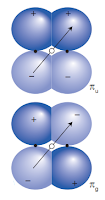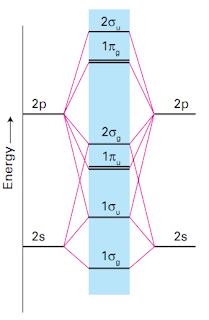博文
学而时习之-Molecular orbital theory
||
关注:
1)什么是分子轨道理论? 怎样一句话概括其本质2)如何画分子轨道图3)如何读分子轨道图
Explanation of irreducible representations t from Yuta:
1) a、b、e分别表示什么?
答: 沿中心轴旋转,如果对称性改变则为b,不变则为a; e的情形较为复杂,通常含有简并轨道的称为e;
2) g和u表示中心对称,中心反演对称的为g,不对称的为u; g和u 前面的数字表示,是否镜面对称,1表示镜面对称,2表示不是镜面对称
gerade: 国际音标:/ɡəˈʀaːdə/ 均匀的;直的,不弯的,笔直的;直接的,坦率的

网络摘录1:Gerade and ungerade
网络摘录:http://www.chm.davidson.edu/ronutt/che115/OrbitalRep/OrbitalRep_Tutor.htm
Tutorial for Experiment: Orbital Representation
Write the Lewis electron dot formula for NH3.

Determine the type of hybrid orbitals on the nitrogen atom in NH3. See Flow Diagram for help.
Lone pairs on the central atom? Yes
Number of electrons around the central atom? 8
Is the central atom in the 2nd period or is it bonded to a halogen or oxygen atom? Yes
Number of "groups" on the central atom? 4 "groups" = number of hybrid orbitals needed
Hybridization that provides 4 hybrid orbitals? sp3
Sketch relative energy level diagrams for the atoms in order to identify the orbitals that can be linearly combined to form bonding molecular orbitals.

Select "sp3" (place cursor on sppp Orbitals to highlight it in dark blue and click the left mouse button) from the Components pop-up menu .

Select "N" (highlighted in dark blue) from the Element pop-up menu as the central atom.

Place the cursor at the point in the window where you wish to draw the isodensity surface, press the left mouse button and move the mouse slightly up or down.

One of the sp3 hybrid orbitals on the nitrogen atom and the 1s atomic orbital on the hydrogen to the right of the nitrogen atom can linearly combine to form a bonding molecular orbital . A qualitative representation of the isodensity surface of this bonding molecular orbital can be constructed by overlapping the isodensity surfaces of the sp3 hybrid and 1s atomic orbitals. Since the isodensity surface of sp3 hybrid orbital on the right is in the plane of the page, we will select the "s" isodensity surface "In the Plane" of the page from Components pop-up menu.

Next, select "H" (highlighted in dark blue) from the Element pop-up menu .

Place the cursor to the right of the nitrogen atom, and click the left mouse button . If you wish to change the color of the "s" isodensity surface, continue to press the left mouse button and move the cursor horizontally until the color changes from blue to red.

To move the representation of the isodensity surface of the 1s atomic orbital, place the cursor over the isodensity surface. When the chemical symbol for the hydrogen atom is "highlighted", press theright mouse button to display the pop-up menu. Select "Move" from the menu and click the left mouse button.

Move the cursor to the left until the isodensity surface of the 1s atomic orbital overlaps the isodensity surface of the sp3 hybrid orbital on the right, and click the left mouse button.

The representations of the isodensity surfaces of the remaining bonding molecular orbitals are constructed in a similar fashion (Steps 7 - 11). The isodensity surface of one of the sp3 hybrid orbitals on the nitrogen atom is above the plane on the page. The "In Front of the Plane" representation of the isodensity surface of the 1s orbital is chosen to overlap with this sp3 isodensity surface. The "Behind the Plane" representation of the 1s isodenstiy surface overlaps with the third sp3 isodensity surface.

Select "Electron Pairs" (highlighted in dark blue) from the Components pop-up menu.

Add four pairs of electrons to the right of the isodensity surfaces.

Move one pair of electrons inside each representation of an isodensity surface of a bonding molecular orbital. These electron pairs identify the "occupied" molecular orbitals and correspond to the bonding pairs of electrons in the Lewis electron dot formula for NH3. The actual isodensity surfaces, of which these drawings are rough representations, enclose the regions in space in which there is at least 98% probability of finding the electron pair. The last pair of electrons is placed in the representation of the empty sp3 isodensity surface. This pair of electrons is the lone pair in the Lewis formula for NH3.

To label the "sp3" isodensity surfaces, select "sp3" (highlighted in dark blue) from the Label pop-up menu on the tool bar.

Add four "sp3" labels to the right of the representation.

Move one label inside each sp3 isodensity surface.

Select "s" (highlighted in dark blue) from the Label pop-up menu on the tool bar and "1" as the value of the quantum number n from the Quantum Number n pop-up menu.

Place one "1s" label next to each isodensity surface of a 1s atomic orbital.

Label the isodensity surface with the lone pair of electrons by selecting "Lone Pair" (highlighted in dark blue) from the Label pop-up menu.

Place the "Lone Pair" label above the isodensity surface.

Next, select "Arrow" (highlighted in dark blue) from the Label pop-up menu.

Place the arrow to the right of the drawing, and then move it directly between the label and the isodensity surface with the lone pair.

Finally, label the isodensity surfaces of the bonding molecular orbitals in a similar fashion.

https://wap.sciencenet.cn/blog-567091-737914.html
上一篇:build tuition之常见概念辨析
下一篇:纳米科学与Extended Hückel method
全部作者的其他最新博文
全部精选博文导读
相关博文
- • Minerals线下恳谈会:履践致远、与时偕行——对话中国科学院广州地球化学研究所期刊合作学者
- • 聚英才 建高地 | 北京理工大学“特立青年学者”全球招聘开启
- • 700年后日本或濒临灭绝?日本学者推算预测:届时或仅剩1名15岁以下孩子
- • [转载]【同位素视角】非英语母语学者如何区分’e.g.’, ‘i.e.’, ‘namely’与‘such as’等混淆难题
- • 美国佐治亚大学等机构学者:刈割策略对Bulldog 805紫花苜蓿+Tifton 85狗牙根混播草地产量及品质的影响
- • 美国堪萨斯州立大学、密苏里大学等机构学者研究成果:土壤水分管理策略和品种多样性对紫花苜蓿产量、营养品质和农场盈利能力的影


